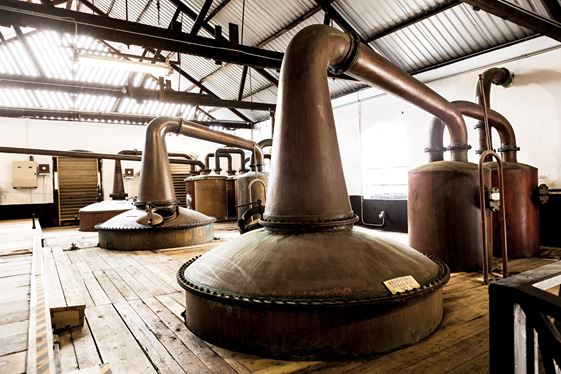History
Rum making was first discovered in the West Indies around the 1600s, when Barbados quickly became a gateway for the sugar trade. Sugar needed refining before transport, and a by-product of that process is molasses. Traders were quick to realise this waste product could be used as a base material for making alcohol.
The resultant spirit – often called fire water or “Kill Devil”, for its potent properties – was traded for slaves amongst other things. Eventually the terms Rumbullion or Rumbustion caught on for the drink, presumably due to the commotion that could erupt following heavy consumption. And lo, we get the name rum.
It’s important to note the connection between rum production and the darker history of the Caribbean. It’s something that defined the product for hundreds of years. Although it was appropriated by British and other European colonisers, the modern industry now has many native owners. And of course, distillation methods are much more advanced and sophisticated. It has become an integral part of the culture and economy and supports jobs for thousands of people in relatively remote areas.
The real turning point in rum’s story, though, was emergence of tiki cocktails in the 1940s. Rum was given its moment to shine, with iconic drinks like the Mai Tai sweeping cocktail bars. Having this fun, approachable and easy-going persona has made it one of the most popular spirits on the planet.
Production
Rum can be made from either molasses, as mentioned earlier, or from pressed sugar cane juice. The latter, typically known as “agricole” or agricultural rum, is much more fragrant, grassy and vegetal. You can learn more about in Dawn’s article Agricole – rhum or rum?
Whatever the base material it then needs fermenting, either through the controlled addition of yeast or sometimes just in open vats with wild yeast. This creates a kind of sugar cane wine – deeply unpleasant to drink, but full of esters and congeners (basically flavour molecules) that are concentrated and purified through distillation.
It’s then entirely up to the distillery if and how long they might age the rum for. Most producers will have a range of products in their stable though, so you can choose whatever suits your needs.
Types of Rum
Being such a maverick spirit, rum doesn’t like to stick to rules that often. The most commonly accepted categories rum is grouped into are:
• White rum – generally unaged, but sometimes aged then charcoal-filtered (to make it clear again). Best for mixing, or a go-to Daiquiri base.
• Golden rum – unaged, but with colouring added.
• Aged rum – matured in wood, giving it a darker, richer body.
• Spiced or flavoured rum – typically vanilla, clove or lime is added, along with sugar.
In an attempt to classify things a little more, however, rums can also be grouped according to how they’re distilled – traditional pot, modern column, or a blend. The first characterises rums with more full-bodied, fruited character, whereas those made in a column still tend to be lighter and cleaner. And of course, there are plenty of rum bottlers out there who blend to their own recipes.
Flavour
Despite being made from sugar, not all rums are necessarily sweet. Once distilled, the spirit has no sugar left in it. Sweetness tends to come from either ageing, or when a ‘dosage’ of sugar cane juice, molasses or any other additives have been mixed in (as per a spiced rum).
When it comes to buying rum however, it’s essential to have an idea what you’re planning on using it for. White rums may be perfect for a Daiquiri or Mojito, but something richer or spiced is perfect for say a Dark & Stormy (rum & ginger beer). If you just feel like sipping on a nice neat glass of spirit, though, unadulterated aged styles will give you something to really contemplate. That’s the beauty if rum – there’s always something to suit your mood.

